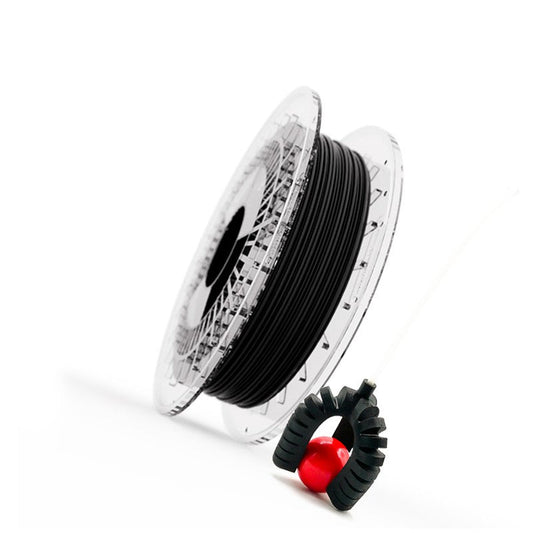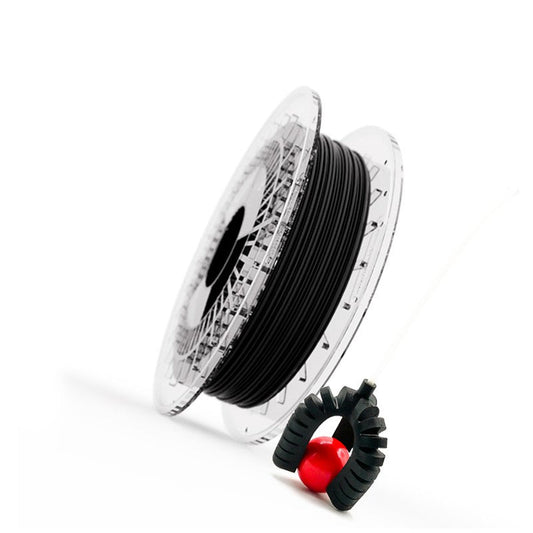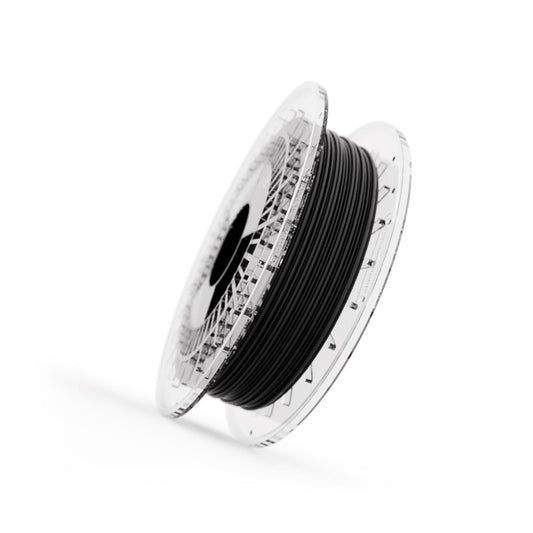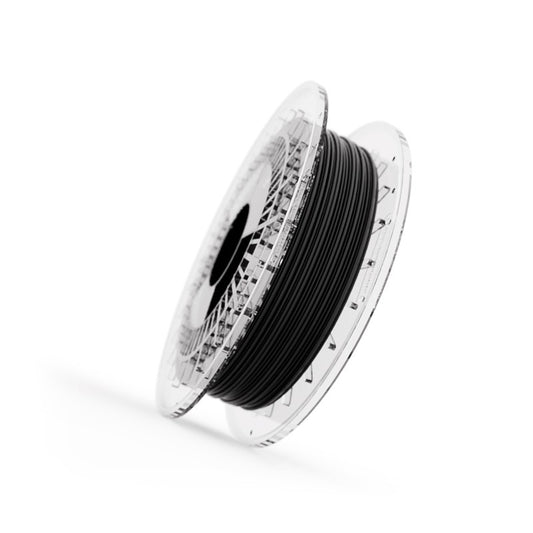Zweifel bei der Verwendung von flexiblem Filament für den 3D-Druck? Wir beantworten sie.
Häufige Fragen zum 3D-Druck mit flexiblem Filament
Entlarvung der Mythen über 3D-Druck mit flexiblem Filament oder TPU. Wir helfen Ihnen und lösen alle Ihre Zweifel!

Was ist ein flexibler Filament?
Ein flexibles Filament ist ein Material, das in 3D-Druckern verwendet wird und die Fähigkeit besitzt, sich zu biegen und zu flexen, ohne zu brechen. Dieser Filamenttyp besteht aus elastomeren Polymeren, die ihm seine Elastizität und Flexibilität verleihen. Beim Drucken mit flexiblem Filament können Objekte erstellt werden, die gebogen, verdreht oder zusammengedrückt werden können, ohne zu brechen. Dies macht es ideal für die Herstellung von Teilen, die einen gewissen Grad an Flexibilität erfordern, wie zum Beispiel Spielzeug, Schuhwerk, Gummiteile, Prothesen und anderes.
Es ist wichtig zu beachten, dass das Drucken mit flexiblem Filament aufgrund seiner elastischen Natur herausfordernder sein kann als mit anderen Materialien. Es erfordert spezielle Anpassungen in den Druckereinstellungen, wie Druckgeschwindigkeit, Temperatur und Retraktion, um optimale Ergebnisse zu erzielen.
Was ist TPU-Filament?
TPU-Filament (Thermoplastisches Polyurethan) ist eine Art von flexiblem Filament, das im 3D-Druck verwendet wird. Es gehört zur Familie der flexiblen Filamente aufgrund seiner Fähigkeit, sich zu dehnen und zu biegen, ohne zu brechen. TPU ist ein elastisches und haltbares Material, was es ideal für den Druck von Objekten macht, die Flexibilität und Haltbarkeit erfordern.
Es wird weit verbreitet in der Herstellung von Schuhwerk, Sportbekleidung, medizinischen Produkten und Spielzeug, unter anderem, verwendet. TPU-Filament zeichnet sich durch seine hohe Beständigkeit gegen Abrieb, Verschleiß und Chemikalien aus. Es ist auch resistent gegen Öl, Wasser und ultraviolettes Licht. Zusätzlich ist es kompatibel mit einer breiten Palette von Farben und kann in verschiedenen Härtegraden gedruckt werden, von weich und flexibel bis hin zu härter und widerstandsfähiger.
Ich habe gelesen, dass das Drucken von flexiblem Filament sehr schwierig ist. Ich glaube, das ist nichts für mich.
Nichts könnte weiter von der Wahrheit entfernt sein! Es ist weder schwieriger noch einfacher, es ist einfach anders als das Drucken mit anderen Arten von Materialien, an die Sie gewöhnt sind.
Das Wichtigste ist, Ihren Drucker zu kennen. Wissen Sie, ob es sich um ein {{ ... }}Direktextrusion oder Bowdenund den Typ des Extruders, den es hat, wenn es istall-metal oder enthält ein PTFE-Rohrentlang der gesamten Länge des Hotends. All dies wird den bestimmen.Shorevon flexiblem Filament, wie Filaflex, mit dem Sie drucken können.
Tatsächlich werden immer mehr wettbewerbsfähig bepreiste Desktop-Drucker auf den Markt gebracht, die sehr gut mit flexiblem Filament drucken und arbeiten.
Sollten Sie jedoch Hilfe und Unterstützung beim Einstieg benötigen, werden wir Sie stets schnell hinsichtlich des Filaments beraten und anleiten, das am besten zu Ihren Bedürfnissen und Ihrem Drucker passt. Darüber hinaus finden Sie auf unserer Website eine breite Palette an Lerninhalten, die Sie jederzeit konsultieren können, um unsere flexiblen Filamente, wie Filaflex, erfolgreich zu drucken.
Gibt es verschiedene Arten von flexiblem Filament?
Natürlich, unter Berücksichtigung ihrer Shore-Härte. Innerhalb der Familie der flexiblen Filamente oder TPU können wir eine breite Vielfalt von TPUs finden, die wir entsprechend ihrer 'Shore-Härte' klassifizieren können. Die Shore-Härte ist ein sehr wichtiger Parameter, der uns hilft, die Elastizität eines flexiblen Filaments zu bestimmen.
Zum Beispiel haben wir in unserem Sortiment des Filaflex flexiblen Filaments verschiedene Shore-Härtegrade dieses Materials: 60A, 70A, 82A oder 95A. So können wir über dasselbe Filament sprechen, aber mit unterschiedlichen Verhaltensweisen aufgrund ihrer elastischen Eigenschaften.HierWir haben dieses Konzept ausführlicher besprochen - verpassen Sie es nicht!
Eigentlich weiß ich nicht, welches Filament der 4 Filaflex Shore-Härtegrade ich verwenden sollte. Filaflex 82A, Filaflex 95A, Filaflex 70A oder Filaflex 60A?
In diesem Fall probieren Sie sie aus und entscheiden Sie! Tatsächlich haben wir ein Musterpaket von je 50g verfügbar, das Sie überprüfen können.here, das die 4 Filaflex Shore-Härtegrade umfasst. Es ist das perfekte Paket, um die verschiedenen Elastizitäten des Filaments zu testen und so zu bewerten, welches für Ihr Projekt am besten geeignet ist, bevor Sie eine größere Spule kaufen. Wie immer stehen wir Ihnen jedoch gerne zur Verfügung, um Sie zu unterstützen und zu beraten.
Ich denke, dass das Filaflex 82A Filament das richtige Filament für das ist, wonach ich suche, aber könnte ich es ausprobieren, bevor ich eine Spule kaufe?
Natürlich! Du hastzwei Musterpackungenvon Filaflex 82A verfügbar, ein einfarbiges Paket mit 4 Grundfarben, wie schwarz, weiß, transparent und grau, und ein weiteres Paket mit den Farben rot, blau, gelb und grün. Auf diese Weise können Sie das Filament zu Ihrer Sicherheit testen, bevor Sie eine größere Spule kaufen.
Ich weiß nicht, welches flexible Filament am besten für mein Projekt geeignet ist.
Wenn Sie trotz allem, was Sie gelesen haben, immer noch nicht sicher sind, welches Filament am besten für Ihre Bedürfnisse und Ihren Drucker geeignet ist, kontaktieren Sie uns unter info@recreus.com und wir werden Sie unverbindlich beraten und unterstützen.
Ist Filaflex sicher für den Hautkontakt?
In der Tat! Filaflex ist ein Material, das hautverträglich auf der kutanen Ebene ist, nicht toxisch ist und keine Gerüche erzeugt. Filaflex wurde und wird weiterhin verwendet, um viele Anwendungen wie Textilteile und Zubehör, sowie Einlegesohlen und Prothesen, die in Kontakt mit der Haut kommen, zu erstellen. Es sollte jedoch nicht intrakutan (innerhalb der Haut) eingeführt werden und wird nicht für die Verwendung in Wunden oder Dekubitus ohne Durchführung der entsprechenden toxikologischen Tests für die jeweilige Anwendung empfohlen.
Ist Filaflex für den Hautkontakt und den Kontakt mit Lebensmitteln zertifiziert?
Unser Produktions-, Lager-, Vorbereitungs- und Lieferprozess entspricht den Vorschriften der guten Herstellungspraxis. Darüber hinaus haben wir auf Anfrage ein Konformitätsschreiben verfügbar, das die Produkte und Farben im Filaflex-Sortiment angibt, die Rohstoffe verwenden, die den europäischen Normen und FDA-Vorschriften entsprechen.
Bezüglich des Zertifikats muss dies am Endprodukt erfolgen, das mit Filaflex gedruckt wird. Es ist eine Verantwortung, die vom Vertreiber übernommen werden muss, der es auf den Markt bringt, entsprechend dem Verarbeitungsprozess und seiner spezifischen Verwendung.
Welchen 3D-Drucker kann ich verwenden, um Filaflex 60A und 70A zu drucken?
Im Allgemeinen sind die grundlegenden Voraussetzungen für das Drucken mit diesen Filamenten, ebenso wie mit Filaflex 82A, dass der Drucker über einen Direktextruder verfügen muss und das Hotend nicht vollmetallisch sein darf. Nachdem dies geklärt ist, die Drucker, die gut mit diesen Shore-Härten arbeiten, sind:
Mit Filaflex 70A
- Artillery Genius and Sidewinder X1
- Anycubic Predator
- Creality CR-10, Ende-3 und Ender-3 Pro
- Printrbot
- Sovol Sv01
- Ultimaker 2+, S3 und S5 (konsultieren Sie unser Team)
- WitBox 2
Mit Filaflex 60A
- Artillery Genius and Sidewinder X1
Es gibt wahrscheinlich noch viele mehr, aber dies sind diejenigen, von denen wir wissen, dass sie funktionieren, entweder durch das Feedback unserer Kunden oder durch unsere eigene Erfahrung.
Ich habe gelesen, dass es nicht empfohlen wird, flexibles Filament auf Bowden-3D-Drucker-Extrudern zu drucken. Könnte ich Filaflex mit meinem Bowden-Extruder drucken?
Es ist komplizierter, flexibles Filament mit einem Bowden-Extruder zu drucken, weil das Material von der Spule durch das gesamte Druckerröhrchen zum Extruder geschoben werden muss (denken Sie an das Sprichwort „man kann kein Seil schieben“).
Was kann ich tun, um flexibles Filament auf meinem Bowden-Extruder-Drucker zu drucken?
Zuerst hängt es von der Shore-Härte des flexiblen Filaments ab, das Sie drucken möchten. Im Fall der Filaflex-Reihe ist das Filaflex 95A Filament mit diesem Typ von Extrudern kompatibel und Sie werden keine Probleme beim Drucken damit haben.
Bezüglich Filaflex 82A, um diese niedrigere und weichere Härte drucken zu können, muss das Rohr ausPTFEMit diesem Material mit niedriger Reibung verhindern Sie, dass das Filament im Inneren des Schlauchs kleben bleibt und ermöglichen einen besseren Fluss des Filaments.
Für den Druck weicherer Filaflex Shore-Härten, wie 70A und 60A, wird es viel schwieriger sein, und wir empfehlen es nicht, da es von vielen anderen Faktoren abhängt.
Um mehr über Bowden-Extruder-Drucker und den Druck mit flexiblem Filament zu erfahren, informieren Sie sich bitte weiter.here.
Ich drucke mit meiner Spule aus flexiblem Filament, aber das Finish ist nicht ganz richtig und die Oberfläche sieht etwas klumpig aus, woran kann das liegen?
95% der Zeit handelt es sich normalerweise um ein Feuchtigkeitsproblem, das schnell durch Trocknen der Spule vor dem Drucken gelöst wird. Obwohl Recreus erschöpfende Qualitätsmanagementprozesse bei der Produktion unserer Filamente durchführt, um sicherzustellen, dass sie keine Feuchtigkeit aufnehmen, ist es unvermeidlich, dass das Filament nach Erhalt durch den Kunden etwas Feuchtigkeit aufnehmen kann. Daher empfehlen wir, die Spulen außerhalb jeder feuchtigkeitsanfälligen Atmosphäre aufzubewahren oder zu lagern.
Um das Finish Ihres Teils zu verbessern und die Feuchtigkeit von der Spule zu entfernen, haben Sie mehrere Optionen. Von der Verwendung eines Filamenttrockners oder eines Lebensmitteltrockners bis hin zur rudimentäreren und konventionelleren Methode, die darin besteht, die Spule in Ihrem Ofen bei einer Temperatur von 50ºC im Umluftmodus für 3 Stunden einzuführen. Sie können konsultierenhereWeitere Informationen zu 'Feuchtigkeit vs. flexiblen Filamenten'.
Benötigen Sie weitere Hilfe?
Und vergessen Sie nicht, egal was Ihre Frage ist, und, falls wir sie leider noch nicht in diesem Abschnitt oder sogar in demFAQsIm Abschnitt "Support" (auf den Sie über das Hauptmenü dieser Website zugreifen können), freuen wir uns, von Ihnen über unsere E-Mail info@recreus.com zu hören, um alle Ihre Zweifel und Fragen zu klären.









